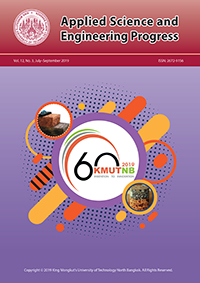Concept Development of Compact Automatic Filling Machine (CAFM)
Main Article Content
Abstract
Activities of daily life are effective with increased involvement and excitement. Manufacturers, especially who are concerned about health-related products, offers and keep improving their products with extreme convenience function and innovative design to meet customer’s requirements satisfaction. An average amount of water intake of people has increased in the recent years and thus, rising consumption of bottled water. This key factor drives the bottled water packaging market globally. A home water treatment unit is even though the popular choice for investing and saving money, people are highly concern on wastage, especially spilling water during the filling process. A Compact Automatic Filling Machine (CAFM) proposed in this research study, allows automatic bottling to fulfil the basic need of drinking water with concern to speed. In addition, the paper proposed a novel idea of filling instead of the general approach of filling one by one. The proposed innovative filling approach provides better and easy interfacing panel with multi-filling platform. It can be installed in various large-scale consumer service providers including canteen, school and Small and Medium-sized Enterprises (SMEs) to introduce refilling for selling bottles. Further, high-income earners and elders who require assistance can also use it as it requires minimum time and human-labour involvement. Refilling of bottles not only saves the cost of buying a new packaged drinking water but also reduces the number of disposable plastic water bottles consumption.
Article Details
References
[2] H. Y. Chen and K. L. Huang, “Construction of perfume bottle visual design model based on multiple affective responses,” in Proceedings of the IEEE International Conference on Advanced Materials for Science and Engineering: Innovation, Science and Engineering, IEEE-ICAMSE 2016, 2016, pp. 169–172.
[3] K. T. Ulrich and S. D. Eppinger, Product Design and Development, 4th ed., Singapore: McGraw-Hill Education, 2007.
[4] Thought Co. (2016). How Much of Your Body is Water. Thought Co. New York, USA [Online]. Available: http://goo.gl/2O1Pw0
[5] Ministry of Public Health. (2017) Health Fact Sheet. Ministry of Public Health. Nonthaburi, Thailand [Online]. Available: http://goo.gl/Y94 3cA (in Thai).
[6] Thai Health. (2017). Thai Health Promotion Foundation. Thai Health. Bangkok, Thailand [Online]. Available: http://en.thaihealth.or.th (in Thai)
[7] J. Islam and Z. Rahman, “The impact of online brand community characteristics on customer engagement: An application of stimulusorganism-response paradigm,” Telematics and Informatics, vol. 34, pp. 96–109, 2017.
[8] Statistic Brain. (2013, Jul.). Business That Can Make a Million US Dollars in USA.We Go Inter. Bangkok, Thailand [Online]. Available: http://goo.gl/A5Bfic (in Thai).
[9] M. Lucia, K. Harley, D. H. Wayne, and N. Bettina, “Emotional brand attachment and brand personality: The relative importance of the actual an the ideal self,” Journal of Marketing, vol. 75, pp. 35–52, 2011.
[10] B. Cathy and P. L. S. Paul, “Decision support for the design of affective products,” Journal of Engineering Design, vol. 20, pp. 477–492, 2009.
[11] M. D. Deana, D. Howard, and C. Jonathan, “Design and emotion,” Journal of Engineering Design, vol. 20, pp. 433–435, 2009.
[12] K. Junsheng and J. Pingyu, “Product platform design for a product family based on Kansei engineering,” Journal of Engineering Design, vol. 20, pp. 589–607, 2009.
[13] M. L. Saul. (2016). Maslow’s Hierarchy of Needs. Simply Psychology. UK [Online]. Available: https://www.simplypsychology.org/maslow.html
[14] Prolifixent. (2005), Water Dispenser Servicing, Parts and Maintenance. Nairaland. Nigeria [Online]. Available: http://goo.gl/r8JWro
[15] B. S. Dhillon, Maintainability, Maintenance, and Reliability for Engineers. Florida: CRC Press, 2006, pp. 97–109.
